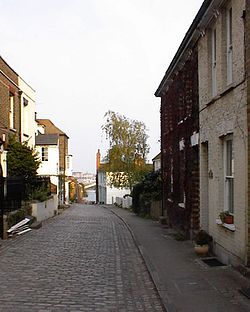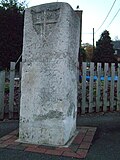Upnor
| Upnor | |
| Kent | |
|---|---|
 Upper Upnor High Street | |
| Location | |
| Grid reference: | TQ757706 |
| Location: | 51°24’37"N, 0°31’34"E |
| Data | |
| Postcode: | ME2 |
| Local Government | |
| Council: | Medway |
Lower Upnor and Upper Upnor are two small villages in Kent, on the western bank of the tidal River Medway. Today it is mainly residential and a centre for small craft moored in the river, but Upnor Castle is a preserved monument, part of the river defences from the sixteenth century.
Origins
Upnor meant "at the bank" being "æt þæm ore" in Old English and "atten ore" in Middle English and "atte Nore" in 1292. However then the meaning changed to "Upon the bank" Middle English "uppan ore" and by 1374 it was "Upnore".[1]
A skeleton of a Straight-tusked Elephant was excavated in 1911, during the construction of Royal Engineer's Upnor Hard.[2]
Lower Upnor
Lower Upnor faces Upnor Reach. It was a single row of housing separated from the river by the roadway, and the hard. It here that one finds the Arethusa training centre run by the Shaftesbury Homes. In living memory the Arethusa was also the name to the training ship moored parallel to the shore. The society had moored a training ship here for over 105 years. The first was the Chichester, but after than all the ships have been called Arethusa. The Last Arethusa was the "Peking", one of the R.F Laeisz's Flying P-Liner 4 masted barques built in 1911, and acquired after 1918 as war reparations. She was sold in 1975 to the South Street Seaport Museum in New York. In recent times extra housing has been built behind this street, exploiting the land exposed by quarrying the steep the hillside that leads to Hoo Common.[2]
Lower Upnor is also the home of two Yacht / Sailing Clubs:- Medway Yacht Club (founded 1880) who purchased land in Lower Upnor in 1948, now comprising approximately 14 acres. Upnor Sailing Club was formed in the last 1960's and they moved into their present Club House (formed from renovating three existing traditional riverfront cottages) is the 1980s.
The Royal School of Military Engineering maintains an equipment storage and training facility in Lower Upnor, which supports the Riverine Operations section in Upper Upnor and the main school across the river in Brompton.
Upper Upnor
Upper Upnor comprises a village street leading to Upnor Castle, including many houses which are finished in Kentish weatherboarding; as well as some terraced streets formerly used by the MOD and also Castle Street. It is on Chatham Reach directly opposite St Mary's Creek.[2]
The Royal Engineers still have a presence in Upper Upnor, the Royal School of Military Engineering Riverine Operations section maintains classrooms, workshops and a hard in Upnor for the training of Royal Engineers Assault Boat Operators and Watermanship Safety Officers, who continue to operate craft on operations all over the world. The section operates Mk 1 and 3 Rigid Raider, and Combat Support Boat as well as teaching use of the Mk 6 Assault Boat. The area is also used for other training purposes by the RSME including practice and test Bomb Disposal tasks by the Defence Explosive Ordnance Disposal School, until its move to Bicester.
Though Upnor Castle only was effective for about 100 years (1559–1667), it was retained as a magazine and ammunition store until the end of the First World War.
London Stones

The London Stones are in Lower Upnor on the shoreline. They mark the limit of the charter rights of London fishermen. The older stone is dated 1204 (it stands in front of the fence of the Arethusa Venture Centre).
Industry
Like other parts of Frindsbury parish, chalk has been extracted, high quality moulding sand has been taken from a pit near the Church, and William Burgess Little built 25 five barges at his yard between 1843 and 1871. The first was the Sarah Little and the last called W.B.Little Finish. James Little built 3 barges here in 1891,1893 and 1895.[3] A Potter's Kiln can be seen on an 1830 watercolour by Susan Twopeny, now in Rochester Guildhall Museum.
The Church
The ecclesiastical parish of Upnor split from Frindsbury in 1884 and was reabsorbed in 1955. The parish church of St Philip and St James (1884)was designed by Ewan Christian RIBA (1814–1895). It is virtually unaltered.[3]
The Military Railway
The army used this area to train a railway engineering force. They built a standard gauge railway from Chattenden to Upnor 1872-3. It was abandoned before 1881, and a 30 gauge line was built in 1885[3] or by the 8th(Railway) Company R.E. in 1898[4] One branch went to Lower Upnor, and the other to the camp by Tower Hill. This line was used to supply armaments from Chattenden, the Lodge Hill Ammunition Depot and the standard gauge at Sharnal Street, to the Warships and the Upnor Magazine. The service closed on 19 May 1961.
In 1965-1967, the Royal Engineers converted the route from Lower Upnor to Chattenden into a road including building a new bridge over Four Elms Hill (the main road through Chattenden village). With great originality they named it Upchat Road.
Outside links
| ("Wikimedia Commons" has material about Upnor) |
- Information about the castle
- The castle as part the Chatham defences
- The History of Shaftesbury Homes and the Arethusa, giving details of the purchase of the Pekin
- The New Museum, who bought the Arethusa in 1975, and restored her.
- More images of both London Stones
- Frindsbury Extra Parish Council
References
- ↑ Glover, Judith (1976,1982,1992). The Place Names of Kent.. Meresborough Books.. ISBN 0-905270-61-4.
- ↑ 2.0 2.1 2.2 Matthews M.A., Brian (1971). A History of Strood Rural District.. Strood Rural District Council..
- ↑ 3.0 3.1 3.2 Barnard, Derek (post 1994). Merrily to Frendsbury-A History of the Parish of Frindsbury.. Private Pub. City of Rochester Society..
- ↑ Saunders MA FSA FRHist, A.D. (1967). Upnor Castle Kent. English Heritage. ISBN 1-85074-039-9.
